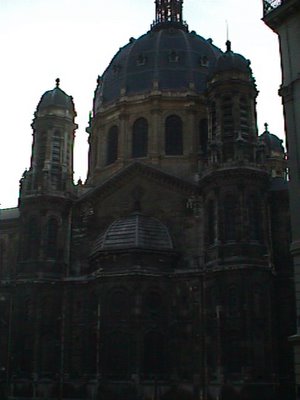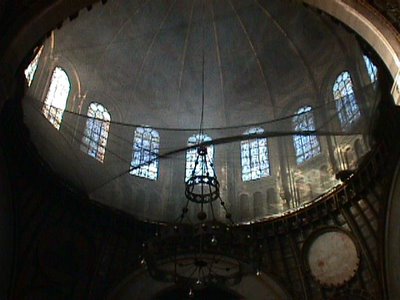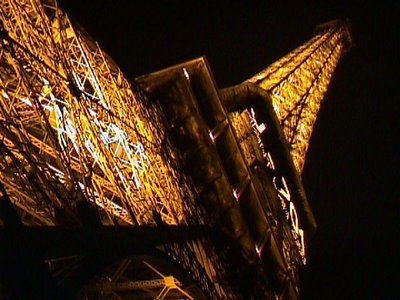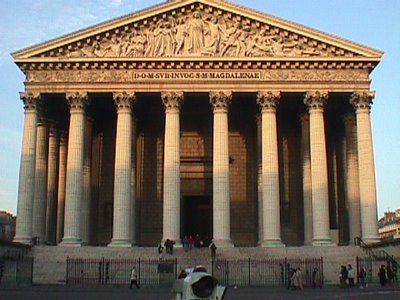
1/31, 1:45 am
Another full day which it is hard to fully document, especially when I’m tired. We probably walked another 10 miles, starting out about 9:30 and walking first to the ancient church of St. Chapelle, which is inside the Palais de Justice. It absolutely brings one back 500 years (and more), and the stained glass in the main chapel was breathtaking. There was a lower chapel downstairs (for the unwashed masses; the upper chapel was reserved for royalty) , and I got a few photographs in spite of the penetrating cold--it is not heated. Then a wander thru town past the Tower St. Jacques to the Pompidou Center, which was not yet open. Next to this there was another mid-size church, St. Merri, which we went in and photographed. Another beautiful, slightly dilapidated church with a beautiful organ. It seems some famous people had played it (I think Gigout was mentioned, but I don’t think he held a title there).

We intended to head toward La Madeleine, but managed to miss it and ended up all the way North at Sacre Coeur. This is quite a walk. We had lunch along the way, long skinny sandwiches at a little bright cafe with chickens roasing on an open-spit oven in the back, and a fussy circuit breaker which kept shutting off power to the whole place. Sacre Coeur is a relatively new church (completed by 1914, I think) but is still fantastically huge. We payed the fee and toured the crypt below and then climbed the zillion stairs to the huge dome above, from which one can survey the entire city from a catwalk behind pillars at the base of the dome. This is way the hell up, and particularly so when the church is on the highest hill in Paris to begin with. The little walkways and narrow stone staircases and 10-story circular staircase all remind one of the endless details that someone had to figure out in advance and then people had to work out in stone. Fantastic. This was a high point.

On the way back down toward the Madeleine, we ran across St. Augustin, another very old, fabulous, huge stone church, and we took a bunch more pictures and listened to an organist practicing Bach and others on the small-ish choir organ. The Grand organ in the back was beautiful to look at, and one wonders if it still works. I was particularly taken with this building, as it was gigantic and seemed neglected and was kind of falling apart. The entire opening to the huge dome at the crossing, high overhead, was covered with a screen, presumably because stuff was falling down and was a risk to people.

La Madeleine was close by, and we looked around it a bit. I learned that the titular organist here is Francois Henri Houbart, and the church was in the best shape of any we’d seen. One can see that the interior was less church-like than the others (there appears to have been some debate as to just what the building ought to be used for once it was finished 150 years ago--train station, government building, art gallery), and it’s not as grand in scale as the big two or three. Best of all, there was to be a concert of Vierne’s Messe Solemne this very evening, with Mr. Houbart at the console (as well as the assistant organist, Yves Castagnet, at the choir organ). We rushed back to the hotel for a bit of rest, and then took the train back to the church for the concert, which was fantastic. The organ is simply huge and grand and awe-inspiring. The performance was flawless but for a few flat notes from the 12 singers. Houbart began with an improvisation after Vierne, which was moving and effective and slightly modern but still rooted in the fabulous tonality of Tournemire and Durufle. There were lots of briefcases, and people were stopping by on their way home from work for an hour of fantastic, Parisian beauty.
I absolutely love this.

After this we walked past the Orangerie (which was closed already for the night) toward the Eiffel Tower, stopping for dinner along the way at a cafe which listed things in English along with French. It was, of course, full of Americans. We rode up to the top of the Eiffel Tower afterward, which was so damn high that I was quite scared and didn’t get much out of it, really (I hate heights, unless I'm strapped in and have a window seat). You’re up airplane-high and the views were spectacular, but it was too dark to take pictures and I was too scared to get near the railing. It’s not a rickety structure, but neither is it solid: it’s a huge scaffolding; so one feels every jolt from the elevators in a way that is quite disconcerting. The place was filled to the brim with English-speaking teenagers.

A few observations. There is something about Parisian women that makes them almost universally attractive. One book says it’s confidence--arrogance, if you wish--but I don’t know if that’s everything. The women I find so attractive are not glamorous, but they know how to make a simple but very effective clothing statement, and they present themselves plainly and without pretension. Makeup is spare or absent (always a good thing to me) and their hair is usually not “styled” but simply cut to a middling length and combed luxuriously back. And everyone is thin, or occasionally very obese. One sees few middling-fat American shapes like mine.

I ought to talk a bit about the driving habits of Parisians, which are unlike anything I have seen, even in New York. First, a fair percentage of people get around either on scooter or motorcycle or, in a few cases, bicycles; and these conveyances seem to follow different rules of the road altogether. More in a minute. But the cars seem always to be jammed two or three into a space suitable for one, and the rules for driving and parking are much more lenient. As Chris says, it’s not as if anything goes, or the roads would simply stop working as people parked all the way across a busy lane, but people park in crosswalks and on sidewalks and completely nuzzled up against the car in front of them (or if there’s a narrow space a motorcycle will stick itself into it). Any lane is designated as a turn lane, and it’s not unusual to see someone turn left across two or three active lanes of traffic and escape multiple crashes by what seems only inches. One would think people would honk constantly but they don’t seem to; and yet when they do honk it seems for transgressions half as severe as one sees routinely that don’t get honked at. Back to the motorcycles. They ride at a much faster speed than the prevailing traffic and will take any path available short of the sidewalk (and even that for an instant and at slow speeds). They go the wrong way on bus-only lanes (as do cars on occasion), they ride on the shoulders, and, most hair-raisingly, they ride down the white lines between lanes of stalled or slower traffic, and always at quite a bit faster speed. Knowing the impulsiveness of drivers, their tendency to change lanes as if on a reflex, and especially the tendency for the guy in the middle lane to suddenly decide he needs to make a left turn HERE, it is amazing that death and dismemberment has not removed motorcycles from the transportation pool (or at the very least taught them a different modus operandi).

I always have the same reaction to a new place that I like, which is to want to move there and immerse myself in it. My reaction of this sort is especially strong in this case, as I feel more at home with the basic flavor of Paris than of any city I ever visited. It has the electricity of New York without as strong an undercurrent of seediness and violence, and it has strong links with its rich past. Add to this that the population seems so educated--and not just university-trained, but interested in living literature and architecture and music--and one has a fantastic place to live. There are more pinch-yourself beautiful sights in Paris than I’ve ever seen before, and walking the streets brings one every few blocks to a different, fabulous square or small park or a new neighborhood with its distinctive shops and architecture. Public transportation here is, as one always hears about Europe, a world apart from what one sees in America. The buses and trains are clean and quiet and the interiors are not geared for guerilla operations with hard seats and materials suitable for the harsh chemicals needed to remove graffiti. There IS graffiti here, but nothing like the epidemics in large American cities which makes the whole society seem like it’s under the gun of the disgruntled. Trains seem to come, during the day, literally every two minutes so one NEVER seems to wait, and the buses have their stops placarded on the outside of the bus so that even a novice can get around very easily. It would be very easy not to have a car here, especially when one can take trains throughout Europe and not just around the town here. All of this ties in, of course: gas and cars are expensive, parking is horrendous, populations are dense, and public transportation is good.
2 comments:
Once again, your post brings back a lot of memories for me. I think I may have commented on the last Paris post that this city was my first love and the one that gave me the traveling bug that's yet to be satisfied.
I was always particularly drawn to St. Chapelle. I guess I just found it a little less touristy and ostentatious than Notre Dame (less ostentatious obviously being a relative term for Parisian churches ;-)).
Comme la ville me manque!
Yes, there's a certain intimacy in the royal grandeur of St. Chapelle that just doesn't apply to Notre Dame or St. Eustache. But it IS all relative.
I spent much less time there than you (tho Susan and I are heading there this summer for a couple weeks), but I was, as I say, swept off my feet. I would very quickly fall into things if I could find a reason, or a way, to move there and immerse myself.
We'll spend a bit of time in London as well, which I've never seen. But being a city person, I'm sure I'll be enthralled.
Post a Comment